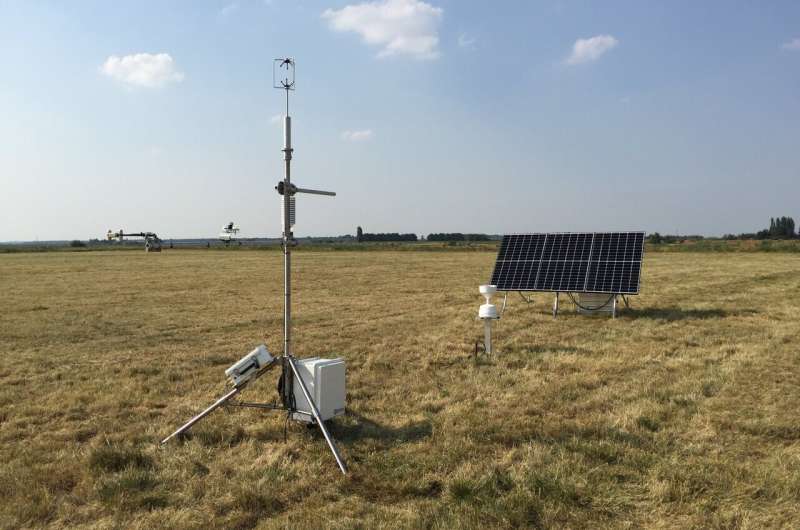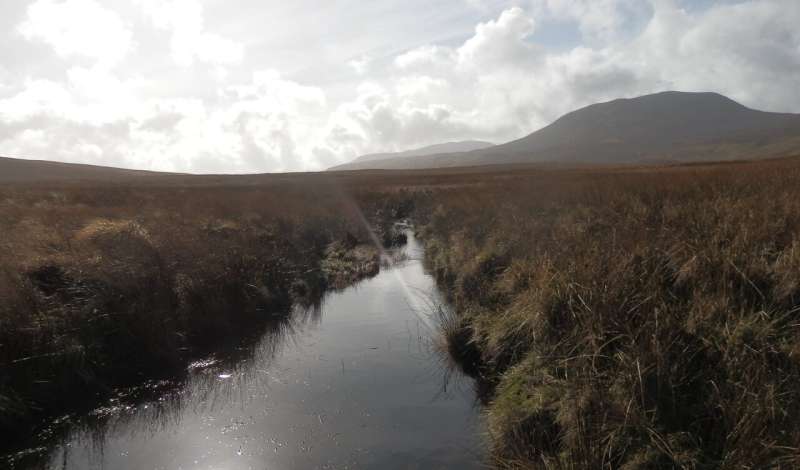Improved management of farmed peatlands could cut 500 million tons carbon dioxide

Substantial cuts in global greenhouse gas emissions could be achieved by raising water levels in agricultural peatlands, according to a new study in the journal Nature.
Peatlands occupy just three per cent of the world's land surface area but store a similar amount of carbon to all terrestrial vegetation, as well as supporting unique biodiversity.
In their natural state, they can mitigate climate change by continuously removing CO2 from the atmosphere and storing it securely under waterlogged conditions for thousands of years.
But many peatland areas have been substantially modified by human activity, including drainage for agriculture and forest plantations. This results in the release, from drained peatlands, of the equivalent of around 1.5 billion tons of carbon dioxide (CO2) into the atmosphere each year—which equates to three per cent of all global greenhouse gas (GHG) emissions caused by human activities.
A team of scientists, led by the UK Centre for Ecology and Hydrology (UKCEH), estimated the potential reduction in emissions by restoring all global agricultural peatlands. However, because large populations rely on these areas for their livelihoods, it may not be realistic to expect all agricultural peatlands to be fully rewetted and returned to their natural condition in the near future.
The team therefore also analyzed the impact of halving current drainage depths in croplands and grasslands on peat—which cover over 250,000km2 globally—and showed that this could still bring significant benefits for climate change mitigation. The study estimates this could cut emissions by around 500 million tons of CO2 a year, which equates to 1 per cent of all global GHG emissions caused by human activities.
A large proportion of the global greenhouse gases from peatlands are produced in Europe and Southeast Asia, with the total land area of many countries including the UK now a net source, not a sink, of GHGs due to emissions from degraded peat.
The study's authors say there is a growing recognition of the significance of peatlands for the global climate system, with efforts to curb emissions by conservation of undrained peatlands and rewetting of drained sites intensifying.

Professor Chris Evans of UKCEH, who led the research, says: "Widespread peatland degradation will need to be addressed if UK and other countries are to achieve their goal of net zero greenhouse gas emissions by 2050, as part of their contribution to the Paris climate agreement targets.
"Concerns over the economic and social consequences of rewetting agricultural peatlands have prevented large-scale restoration, but our study shows the development of locally appropriate mitigation measures could still deliver substantial reductions in emissions."
Professor Evans and his fellow authors recognize the practical challenges, for example controlling water levels and storage, as well as cultivating crops suited to the waterlogged conditions of peatlands, known as 'paludiculture'. Research into wetland-adapted crops is under way but does not yet provide commercially viable large-scale alternatives to conventional farming.
However, the scientists point out there is plenty of scope to partially rewet agricultural peatlands without severely affecting production because many sites are over-drained—sometimes to over two meters—and often when no crop is present.
In addition to increased emissions, drainage of peatlands causes land subsidence and soil compaction, which affects soil health and exposes low-lying areas to increasing flood risk. It also deprives rare wetland-adapted plants, insects and mammals of important habitats.
Professor Sue Page of the University of Leicester, a co-author of the study, says: "Our results present a challenge but also a great opportunity. Better water management in peatlands offers a potential 'win-win' - lower greenhouse gas emissions, improved soil health, extended agricultural lifetimes and reduced flood risk."
The scientists say potential reductions in greenhouse gases from halving the drainage depth in agricultural peatlands are likely to be greater than estimated, given they did not include changes in emissions of the GHG nitrous oxide (N2O) which, like levels of CO2, are also likely to be higher in deep-drained agricultural peatlands.
The study in Nature involved authors from UKCEH, the Swedish University of Agricultural Sciences, the University of Leeds, The James Hutton Institute, Bangor University, Durham University, Queen Mary University of London, University of Birmingham, University of Leicester, Rothamsted Research and Frankfurt University.
More information: Evans et al. 2021. Overriding importance of water table in the greenhouse gas balance of managed peatlands. Nature. DOI: 10.1038/s41586-021-03523-1 , www.nature.com/articles/s41586-021-03523-1
Journal information: Nature
Provided by UK Centre for Ecology & Hydrology



















